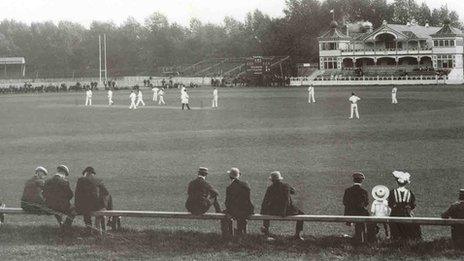Cardiff Arms Park: 149 years of the ugly stadium and the beautiful game
- Published

Cricket was also played at Cardiff Arms Park
When Isambard Kingdom Brunel diverted the River Taff in order to drain the bog which had sat on the site of Cardiff Central train station, little did he know that he had taken the first step on the road of creating the legend which would become Cardiff Arms Park.
Although the name would become synonymous with rugby the world over, the first sportsmen to venture onto this reclaimed land were in fact cricketers, in 1848 - almost 30 years before a rugby ball was ever kicked there.
It was to remain at the heart of Welsh sport for almost 150 years, until making way for the Millennium Stadium in 1999.
But even today the Millennium Stadium's North Stand is a relic of the Arms Park's final incarnation as the National Stadium.
Its stories are retold each year in songs of the Grand Slams and Triple Crowns; the 1905 victory over the unbeatable All-Blacks and "That Try" by Gareth Edwards in 1973.
But now Emyr Young and Bill O'Keefe, who met in their day job guiding tourists around the hallowed turf, have collected together some of the lesser-known gems for their new book, The Arms Park: Heart of a Rugby Nation.
"Our book came about almost by accident," said Mr O'Keefe.
"Emyr and I talked for years about how we ought to write down all the stories we'd heard over the years, but with one thing and another, it's taken us five years to complete it.
"As luck would have it, we've finished on the centenary of the Arms Park's first major redevelopment, when it began to take shape in a form which people alive today may recognise."

The first grandstand at Cardiff Arms Park
"In fact it's quite appropriate, as like the book, the ground itself almost happened by accident, but worked out for the best in the end."
The area took its name from the Arms Park Hotel, which had stood on the site since at least the 17th Century.
Long before a rugby ball was ever kicked there, it had played host to both the ancestors of Cardiff City and Glamorgan County Cricket Club: Riverside FC and Cardiff Cricket Club respectively.
The first record of its use as a venue for paying spectators came in 1872, when crowds were invited to enjoy a day of athletics and acrobatics to celebrate the marriage of the 3rd Marquess of Bute, who owned the land.
An ugly affair
The first stand cost £50 and held just 300 women and children. Men were expected to stand in the mud.
In just 30 years the capacity had mushroomed to 25,000, and such had become the hodgepodge of terraces and temporary stands, the Marquess of Bute ordered the building of Westgate Street, so that he no longer had to look at the stadium.
But even though the Arms Park itself was an ugly affair at the start of the 20th Century, the same could not be said of the rugby teams who made it their home.
In 1884, Cardiff RFC revolutionised the game when they included Frank Hancock as an extra three-quarter, setting the modern trend of teams playing with seven backs.
But arguably Wales' October 1905 victory over the seemingly invincible New Zealanders had an even bigger impact on the future of sport.
"Most people know the story of how Wales defeated New Zealand for the first time, but what's less well known is how that match set a tradition for every single international sporting event, all over the world," said Mr Young.
"In response to the fearsome Haka, the Welsh players began to sing Hen Wlad fy Nhadau, and the crowd joined in spontaneously.
"That's why the anthem is sung before events from the FA Cup final to the Super Bowl.
"And that's a key theme in the book really. Events shaped the stadium, but the stadium also shaped events, and helped to define the modern sense of Welsh identity."
A grandstand was designed by Archibald Leitch in 1912, also behind football stadium architecture at many grounds including Highbury, Ibrox and Villa Park, as the capacity increased to 43,000.
After World War II the ground developments continued, with room for 60,000 fans by the mid 1950s.
'Missed a trick'
The book is published 15 years after the old National Stadium made way for the Millennium Stadium, at a time when the future of the last piece of the old Arms Park is under debate.
Cardiff Rugby Club's 1960s ground, just to the north of the Millennium Stadium, still bears the Arms Park name, but with the Blues having moved away to Cardiff City Stadium, its future has now been questioned, despite them returning for recent games.
"It's important for Cardiff to still have an Arms Park, in whatever form," says Mr O'Keefe.
"I think the WRU have missed a trick in not using the Arms Park brand to market the Millennium Stadium.
"Writing the book has shown me that over the last 130 years, every Welsh generation has looked nostalgically at the previous one as having been the golden era.
"Whilst I don't want to live in the past, I think that sort of history is something we should really be celebrating and capitalising on to get people into Cardiff."